Learn
Tire and Shoe Evidence
Prints
Shoes and tires leave behind prints that can be examined by investigators. These imprints or impressions can be compared to a suspect's shoe or a vehicle's tire to determine if the shoe or tire is the same one that left the impression.
Processing Different Types of Prints
Footwear and tire track prints are divided into three types: visible, plastic, and latent. The type of print will determine the method that investigators used for collection.
Visible Prints
Visible prints involve a transfer of material from the tire or shoe to the surface. For example, a bloody shoeprint or tracks from muddy tires on cement.

Latent Prints
Latent prints are not readily visible to the naked eye. These are created through static charges between the sole or thread and the surface. Powders, chemicals, or alternate light sources are used to find these prints. Latent prints include shoeprints on a tile floor or clean tire tracks on a driveway.
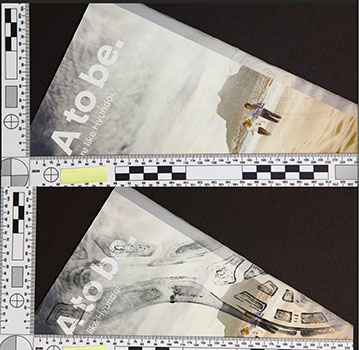
Shoe prints and tire tracks are being left behind, even when the soles may appear clean. For this reason, it is important for investigators to establish a path of entry and exit to the scene and take care to not to inadvertently cover tracks left by the suspect with their own.

If found at the scene, visible and latent prints are collected in similar ways. If possible, the surface of the print is collected and submitted to the lab; this would be possible if the shoe print were on a rug or piece of cardboard.
In most cases, however, the examiner must use a lifting technique to collect the print prior to sending it to the laboratory:
- Adhesive lifter: Used on non-delicate surfaces such as hardwood or tile
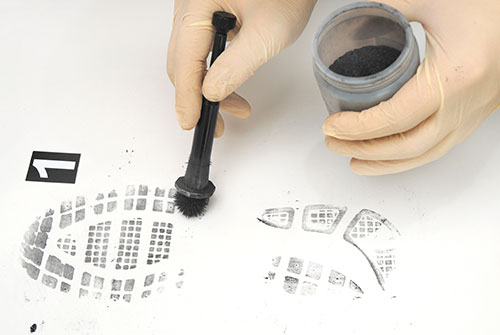
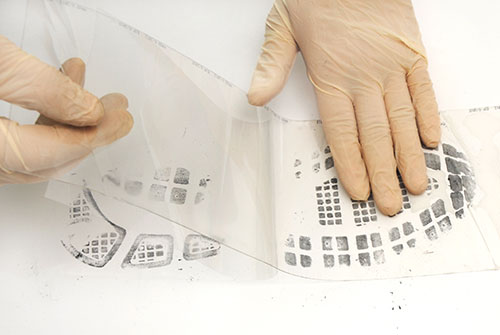
Top: Footwear impression is dusted with black powder to ensure it's visible. Bottom: A clear adhesive sheet is placed over the print and then pulled up or lifted to create a copy of the impression. - Gelatin lifter: A sheet of rubber with low-adhesive gelatin layer that can be used to lift prints from more delicate surfaces


Top: A gelatin lift of a footwear impression. Bottom: The same gelatin lift lit with high intensity lighting. Images by Zalman992 is licensed under CC0. - Electrostatic dust-print lifting device: This device electrostatically charges particles such as dust or light soil, which attracts them to a bonding and lifting film. Open Electrostatic Dust Print Lifter from the Bureau of Criminal Apprehension, Minnesota Department of Public Safety to see what this device looks like and what kinds of prints it can create.
Plastic Prints
A plastic print is a three-dimensional impression left on a soft surface such as sand, mud, or snow.

Plastic prints or impressions can be collected by casting. In this method, a powdered stone material is mixed with water and poured into the impression. When it dries, it is lifted and packaged for transport to the lab.
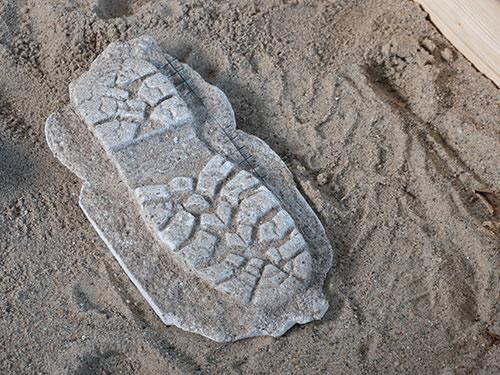
Photographing the Evidence
Prior to collecting prints via lifting or casting, sufficient photographs should be made of both the evidence in the scene (long-range and mid-range), as well as high-resolution images of the individual prints or impressions.
- Investigators must be sure to take photos of the tracks or prints at a 90° angle so that the true size can be determined.
- A scale should also be included when photographing evidence.
Alternate light sources or chemicals may be used to make prints more visible prior to photographing them.

For another example, open this faint, bloody shoeprint from Forensic Science Simplified. The print was treated and chemically enhanced by BLUESTAR® in order to get a more detailed photograph.
Analyzing Evidence
Ideally, the suspect's shoes and/or tires are submitted to the lab along with the collected evidence. Examiners will use the submitted shoes and/or tires to make impressions which can then be compared to the collected evidence. This is usually done using transparency overlays or side-by-side comparisons.

Tools
While toolmark examiners typically use compound microscopes, footwear and tire mark examiners use low magnification and special lighting. They may physically place the items side-by-side for comparison or place digital images side-by-side on large computer monitors for comparison.
Calipers are used to collect precise measurements which provide a quantitative means of comparing prints.
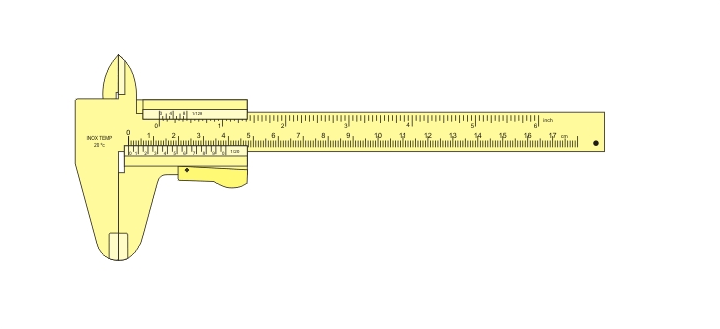
A caliper fits around or inside the object you are measuring. The hundredths place is determined by finding where the lines on the sliding portion align with the stationary component of the caliper.
The "jaws" of the caliper could be placed into tire treads or the sole of a shoe to measure different aspects of the design.

Class and Individual Characteristics
When investigators look at a print, they are seeking to identify both class and individual characteristics.
Class characteristics originate from the manufacturing process. These can be further divided into general class characteristics, which are standard for every item of that make and model and limited class characteristics (also called subclass characteristics) which are unique to a certain mold.
Individual characteristics result from use, not manufacturing, and may include a gouge or crack or a twig or rock stuck in the shoe or tread of the tire.

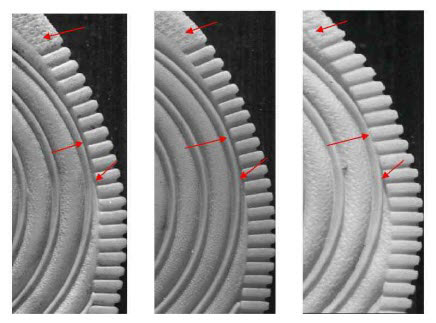
Wear on Shoes or Tires
Wear is an individual characteristic that can yield much information to investigators. Wear characteristics include the pattern of wear and depth of the wear.
For example, the wear on a particular brand of shoe will be different for each person based on the amount of time they have owned the shoe, as well as how and where they walk.
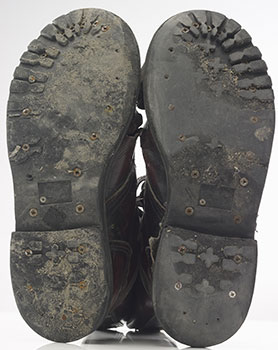

In some cases, an investigator may be asked to submit shoes or tires of other individuals for exclusion purposes, such as from a cohabitant of a home or from a first responder to a crime scene.
Database Comparisons
The FBI maintains a Footwear and Tire Tread File database. Investigators can search this database to find the brand and model of a shoe or tire. Investigators can then contact the manufacturer to get more details for a specific shoe or tire.
Treadmark is another database that stores impressions from previous crime scenes and suspects. When a tire mark or shoe print is found, it can be compared to the others already in the database using four criteria — pattern, size, damage, and wear — to determine if there is a match.
Footwear Impression Evidence
According to an interview with Toronto Police Detective Ed Adach on his 25+ year career, investigators can learn a lot from footprints uncovered at a crime scene. Adach said, "Most impressions are invisible. It's a matter of how I can enhance that footprint to make it visible, and then I can collect it."
Read the following excerpts from Detective Adach's interview below:
Detection Tools
"On something like low-pile carpet flooring - which is one of the worst surfaces for footprints - forensic investigators can collect a dust impression using a static lifter, which is a sheet of Mylar that you place on top of the surface and you give it an electric charge and it's the static electricity that raises the dust off of the surface. When you turn the sheet over, you've got the footwear impression on there."
"If it's a dark floor, the dust will be a lighter color. Therefore, you so I'll be at a crime scene I can just put the oblique lighting on the dark floor and enhance the white dust and photograph it from up above and collect it that way through photography."
"I can look at it and sometimes I can say, 'yeah, I recognize that that's a Converse or a Nike Air Force One or whatever.' But if I don't recognize it - which is often because there's thousands of different styles - I can take the image, a photograph of the [print] image and I'll send it to the [lab] and they can plot the types of patterns that are on the bottom of shoe. Now what it does is, it searches all the manufacturers' types of shoes that are within the database - thousands of different manufacturers, thousands and thousands of different styles - and the computer comes back with possibilities. [The scientists] can look and go, 'oh yeah it looks like this type of shoe' and they can send that back to me."
Analysis
"Once the shoe is collected, I can compare it to the crime scene impression. The class characteristics are the manufacturer's pattern and all the shoes that were made from that cast will have the same class characteristics. So you may have thousands of the same type of shoes and they would leave the same impression, depending on their size."
"But the other type of characteristics were looking for the accidental, or individual, characteristics. These are randomly acquired cuts and nicks occur on the bottom of the shoe as you're walking around, and it's those accidental characteristics that make that shoe unique [and allow investigators to confirm that,] 'yes that shoe made that crime scene impression.'"
Suspects
"Society, I think, has got those impressions of footwear impressions of what we can do from Sherlock Holmes and in novels and that their gait - how they walk - the depth of the foot in soil depends on the density of the soil much more than the weight of the person. The most I can see with the footprint is, if I've got the entire impression, I can estimate a height of the person but that's just an estimate. It's a good investigative tool, [but] I'm not gonna go to court and say 'he's guilty because he's 6 foot 2 inches and the footprint is...a size twelve and a half.'"
"The beauty of forensic evidence in footwear impression evidence is that it can help eliminate suspects. We want to find out at the beginning in the investigation; we don't want to drag somebody through an entire investigation. If I can tell [the detectives] right from the get-go - and I have many times - 'no, that's not your suspect; this is the shoe you're looking for it, not that person'."
"There are other things that I can see at the crime scene you can see from the impressions themselves who's gone where, who's doing what. [For example,] you have a homicide scene where a person's bludgeoned to death. In this case, it was soft compressions that had slight bit of blood on the bottom and he's walking throughout the house. I'd look at the floor, nice clean hardwood floor, I spray the floor with a chemical that enhances the blood impressions, you can see where the person's gone to get the scissors and a hammer and pages from a Bible; you can see the movement within the apartments. The footwear impressions were able to give you a visual of what actually occurred at the time. That evidence can be extremely damning, especially when you have the cuts and nicks at the bottom of the shoe, and I can say without a doubt that that is the shoe that made it."
Knowledge Check #1
Using what you learned from Detective Adache's interview, how are footprints collected from low-pile carpet?
- Static lifter
- Gel lifter
- Casting materials
Answer: a. Static lifter
Knowledge Check #2
Dust prints on a dark floor can be visualized using _______blank prior to photography.
- A flashlight
- A blue light
- A special chemical
Answer: a. A flashlight
Knowledge Check #3
True or False: The investigator can use the footprint to determine the height and weight of a suspect.
- True
- False
Answer: b. False
Knowledge Check #4
True or False: The investigator can use footprints to determine the sequence of events at a crime scene.
- True
- False
Answer: a. True
Knowledge Check #5
Let's identify the print! A footwear impression was left at a crime scene and a casting was made.
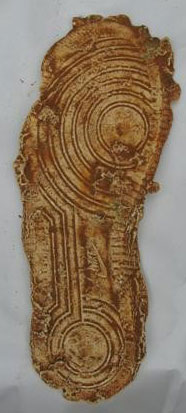
Shoe prints were made from three suspects. Which shoeprint matches the unknown print from the crime scene?
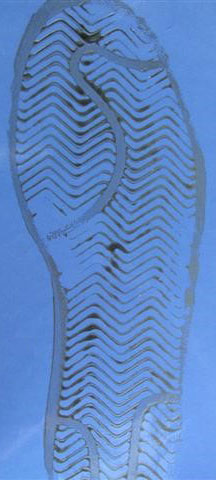


Which print matches? Answer: Suspect 2
These are the key features that make it a match:
- Both shoe prints have a matching circle pattern near the top of the print.
- The straight, long lines match near the center of the print.
- The repeated circle pattern also matches at the heel of the shoe print.
Tire Tread and Track Evidence
This video outlines the information that can be gathered from tire tread and tire track evidence. Note the difference between tire tread and tire tracks, as well as the type of information that can be gathered from each one.
Open Tire Tread and Tire Track Evidence in a new tab
Knowledge Check #6
Which would be used to determine the turning diameter of a vehicle?
- Tire tread evidence
- Tire track evidence
Answer: b. Tire track evidence
Knowledge Check #7
Which of these are studied closely to find individual characteristics and match to a suspect's vehicle?
- Tire tread evidence
- Tire track evidence
Answer: a. Tire tread evidence
Credits
"SKS Forensics: Footprint Analysis", CBC Radio, 2018. https://www.cbc.ca/player/play/1384977987861